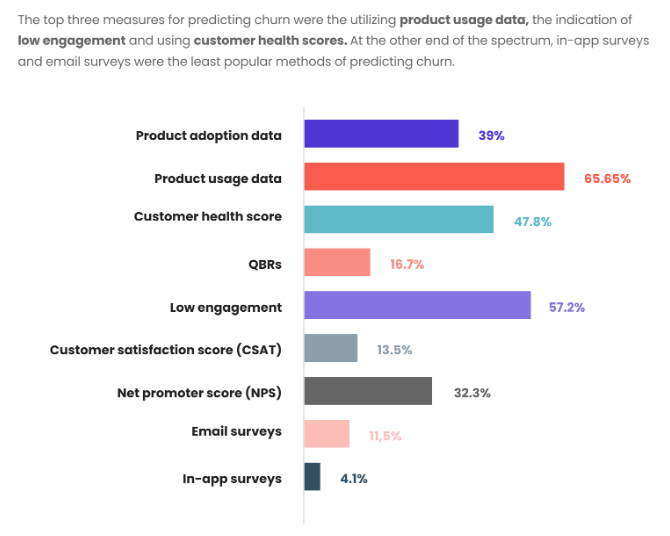Measuring Customer Enablement: The 4 metrics your CE Program should own


As an emerging industry, Customer Enablement as we know it today is pretty… vague.
Not that that’s a bad thing, but the current state of customer enablement basically boils down to ‘making your customer more successful’. And don’t take our word for it - here are just a few of the latest definitions floating around the industry:
Customer enablement is a customer success strategy that provides customers with the resources they need to achieve the desired results from using your product.
Customer enablement refers to the strategies and processes that are drafted to augment a stellar customer experience.
Customer enablement refers to the processes and strategies companies use to enhance the overall customer experience.
But although the ‘what’ of customer enablement may currently be vague, the outcomes and impact to the business make it an essential function for growing customer success teams to invest in. In this article, we break down the four most important metrics that will determine how effective your customer enablement practice is with unique ways to improve your enablement KPI’s as a team.
Download The Guide
Table of Contents
Lowering the Cost of Customer Support
While the focus for many revenue teams over the last several years has been increasing revenue through new sales, Net Dollar Retention (NDR) is increasingly becoming the bottom-line metric that organizations are viewing the success of their CS departments through.
However, the flip side of retaining customers is understanding how much it takes to support them - and customer enablement is in the driver’s seat to drive customer support costs down through better communication and enablement at scale.
According to Gartner, cost optimization exercises and the need to reduce operating expenses are must-haves in 2023, and nowhere can the impact be seen more broadly than Customer Support. Each support ticket that your customers open represents an opportunity to save time and resources through a better user experience - either through a frictionless product experience or a support and success program that anticipates needs before they arise.
There are two key considerations to take into account when trying to reduce the number of support tickets:
Self-Service or in-app customer education
Most customer enablement teams will either link users to their knowledge base or try to create more intensive lesson-based education material in a customer university. While the information inside those articles is probably helpful, it gets buried amidst the hundreds of other pieces of information your customer is sorting through.
Making the customer education journey as self service as possible by directly making material available within your application will help drive down support costs by letting your user educate themselves within the application and not driving them to your knowledge base (or even worse, google searches about your product)
Customer Communication at Scale
How do you send personalized communications to your customers that actually get read? While many teams opt for as many meetings as possible, those take time and are often seen as an annoyance if not a large value-add. Email marketing, while time and cost-effective, typically merits a lower engagement rate and can end up clogging your customer’s inbox - you can send thousands of messages asking for survey participation, only to get dozens of responses.
This is a key reason that most mass customer communications fail - there isn’t a coherent channel strategy for how customers will be reached, or why they’re reached there. While many teams are switching to contextual in-app communications, finding the balance between meetings, email communications, and in-app messaging will be key to a coherent customer communication strategy.

Going Beyond Product Adoption with Use Case Adoption
Product adoption is frequently mentioned as a metric shared between CS and Product Marketing that drives user affinity and lowers the chances that a customer will churn. But what’s often overlooked about product adoption is that there are a few kinds of adoption: adoption of features and adoption of use cases.
Feature Adoption
Feature Adoption is the more traditional approach of measuring how often users are activating individual features. Measured through tools like Pendo or Appcues, feature adoption is going to tell your team if more users are clicking a specific button or if a newly-added page is being seen often enough to make it a worthy investment. Feature adoption is commonly going to be owned by product marketing, as they have deeper insight into product usage, roadmap, and are ultimately responsible in many organizations for rolling out individual features that get used.
Use Case Adoption
Use Case Adoption, on the other hand, is a more holistic method of understanding how customer groups adopt end-to-end use cases that help embed your product into their workflow. Use Case adoption is not easily measured with typical product experience or adoption platforms, because a single use case can consist of a series of actions both inside and outside the product over a period of time.
While we argue that feature adoption should be owned by product marketing, use case adoption can directly be driven by customer enablement, because end-to-end use cases need enablement to be successful.
As an example, let’s consider an Enablix feature - the ability to create custom microsites. While feature adoption would be able to answer questions like how many microsites are being created and who’s creating them, use case adoption might go a step further and answer questions like:
- Do the customers like the look and feel of the microsites?
- Are customers sharing the microsites more often than traditional pieces of content?
- Are microsites driving end-to-end prospect engagement for users, and are they contributing to closed-won revenue?
To put it simply, while product marketing can be held responsible for adoption of inputs, Customer Enablement can own adoption of outputs, and drive expansion of end-to-end use cases for each customer.
A few ways customer enablement teams can drive use case adoption:
-
Customer education, and sharing the ‘what’: Many CS teams will share documentation on ‘how’ to go through a use case - CE teams can effectively motivate the ‘what’ through continuous education at high-value moments.
-
Embedded Learning: Don’t make learning more about your product a chore - instead of longer course-based enablement resources, break it down into bite-sized 3-5 enablement exercises available from directly within the application
-
Reinforcement: Noticing successful or unique use cases? Call them out! Let users know the results they’re achieving with the product and make them feel a part of a larger ecosystem by using your product
Customer Engagement
A customer that’s engaged with your product and brand is one that is significantly less likely to churn. In fact, according to the customer success collective, low engagement with the CS team is the second overall leading indicator that a customer will leave:
But, that begs bigger questions: what is engagement? How is it measured
Within our B2B context, we define customer engagement as any activity where your customer interacts positively with your brand outside of the product. Examples of customer engagement can be as big as co-sponsoring an event and participating in a public case study or as small as finding a meeting useful or getting help from a support article.
Customer enablement needs to take a leading role in fostering engagement - but unfortunately creating those engagement opportunities isn’t as easy as it’s been in the past. Over the last few years we’ve seen a shift in b2b customers’ willingness to hop on “short meetings” or take part in coordinated activities throughout the workday. Even customers know that 15 minutes is never just 15 minutes.
But just because customers don’t want to meet all the time doesn’t mean you can’t foster engagement. Here are a few best practices to measure and foster customer engagement in meaningful ways that drive your business:
Developing a Customer Engagement Score
First and foremost, you need a method of measuring how engaged your customers are. Coming up with a number (or even a rough letter grade) that can serve as a barometer for customer engagement is key to tracking customer enablement’s impact to engagement.
Our advice: start slow. Too many engagement scores end up going sideways and aren’t used because they are too complex, or try to track signals that don’t carry importance. A letter grade signifying how customers are using the product, if they’re attending meetings, and if they’re willing to engage with and promote your brand is a great way to start.
Tracking Customer Engagement Interactions
While organizations will typically track larger activities like attendance at a conference or webinar, too many customer success and enablement teams fly blind to the everyday engagement interactions that their customers are taking that comprise the bulk of brand engagement outside of directly using the product.
Understanding how your users access your knowledge base, support docs, or customer university and the ways that affects their behavior in your product is absolutely critical in determining how engaged a customer is and if the enablement materials you are creating are successful. Having the ability to track your users’ behavior between docs and videos, how long they are spending on what, and the ultimate use case adoption that leads from those analytics allows you to directly link your efforts creating enablement material to the tangible outcomes your customer experiences.
Creating enablement materials without tracking how your customers use them and their ultimate effect on the business can lead to teams creating a lot of unused or unshared material - wasting time and resources for everyone.
Making Engagement an in-app Experience
There are two big problems with making your user leave your product to find educational content on your website or document portal:
There’s too much stuff: Your help and support material is likely scattered across nearly a dozen different places, and that’s before considering that many client onboarding processes include many different one-off documents specific to each client that get lost in inboxes and slack rooms. Especially for growing enterprises, users start to get confused about which locations to go for what kinds of help - which ultimately turns them off to the knowledge base or, even worse, forces them to go to google for information on your product.
Customers lose context: When leaving your product to find help on the product, users lose the context of the question they are in, which is not only confusing, but takes far more time to solve a problem than would if they were able to get in-app help.
Brand engagement goes up when content is available inside the product. Whether it’s about the product, or simply about the company or upcoming events - embedding content within your product is a sure way to raise awareness and customer engagement.
Cross-Sell Win Rate
While the entire revenue organization is going to be responsible for cross-selling products into existing customers (and it’s likely that sales or CS already has teams of people set to do so), Customer Enablement should be responsible for identifying qualified cross-sell opportunities and improving their win rate.
Customer Enablement Qualified Leads
Ideally, you could sell every product you offer to every customer you have - creating endless cross-sell opportunities and dramatically boosting NRR.
But, let’s be honest - the world doesn’t work that way. Not every product that you sell will apply across your entire customer base, and this is where customer enablement can take a key role in identifying which customers are qualified for cross sell, and which aren’t. We define these as customer enablement-qualified leads(CEQL’s), and identifying and qualifying them can be a large lift for CE teams.
CEQL’s are effectively accounts that customer enablement has done diligence on and has validated that there is legitimate benefit or opportunity for your company to cross sell a product into. CE can qualify leads based on varying criteria - some examples including:
- Customer industry
- Interest in product
- Overlap with current use cases
- Engagement with cross-sell marketing or enablement content
Identifying qualified cross-sell accounts creates the ability to measure cross-sell win rate and sales velocity - metrics that customer enablement can own and drive.
Qualified Cross-Sell Velocity and Win-Rate
The simplest metric enablement can track to for qualified cross-sell opportunities is simply the win rate. That is:
Cross-Sell Win Rate = Number of qualified cross sell wins ÷ Number of qualified opportunities
Over time, by better qualifying and understanding your unique customer needs your win rate should go up. But not all cross-sell opportunities are created equal. By better enabling customers and creating brand engagement, the scale and size of cross-sell should also increase - leading us to track a more holistic qualified cross-sell velocity , defined as:
_Cross-Sell Velocity = (Average Upsell Amount _× Number of qualified Opportunities × Qualified Win Rate)
÷
Number of Customers
Measuring qualified win rate separately from velocity will not only give you clues as to how effectively you are identifying qualified opportunities and closing cross-sell, but also if you’re improving the magnitude and number of products you’re upselling and increasing your NRR.
Why Customer Enablement Can't Be Responsible for Customer Satisfaction
Before ending, it’s worth mentioning a key metric that nearly all CS teams measure that customer enablement should not be held responsible for: customer satisfaction.
In short, there are too many moving parts beyond enablements control to effectively own and drive satisfaction. NPS, CSAT, CES… the list goes on, each with different support and success components outside of CE’s purview. While enablement should be able to boost satisfaction scores and many efforts can be tied directly to increases in related KPIs, it’s hard to pin such a large (and important) statistic to the enablement group when so many other teams affect the outcome.
Download The Full Guide Now

